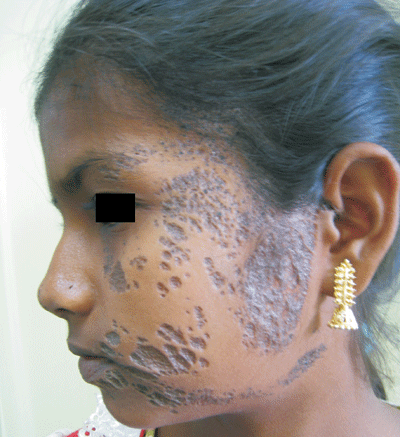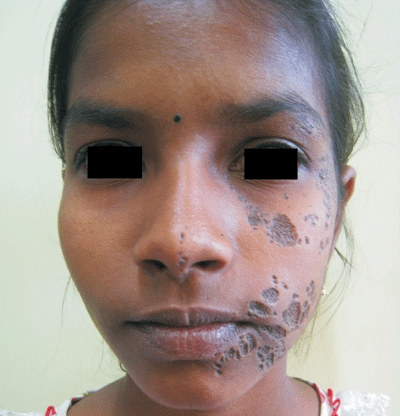A 12-year-old girl presented with asymptomatic skin lesions
over the left side of the face, which were present since
birth. At birth, the lesions were limited to the mandibular
region only but they increased in number with advancing age
to involve the whole left side of the face. Lesion had
stopped growing a year ago. Cutaneous examination revealed
multiple irregular honeycomb like pitted scars. Scattered
comedones were present within these pitted scars. The
lesions were present over the left side of face only
extending from mandibular region to upper part of the
forehead sharply demarcated at midline, ranging in size from
a few millimeters to a few centimeters.(Figs. 1
and 2) There were no such lesions present elsewhere in
the body. Hair, nail and mucosae were absolutely normal.
Examination of the central nervous system and skeletal
system including ophthalmic check-up did not reveal anything
abnormal. Family history was non-contributory. Histology
showed closely placed dilated follicular ostia with
prominent orthokeratotic plugging. The follicular walls were
lined by atrophic epithelium composed of a few layers of
keratinocytes. Based on the clinical and histopathological
findings, a diagnosis of "unilateral facial nevus
comedonicus" has been done for our case. She has been
prescribed topical retinoic acid and referred for laser
treatment, which is best suited for her cosmetic concerns.

(a) |

(b) |
|
Fig. 1 (a) Multiple
irregular honeycomb like pitted scars with comedones
with (b) sharp midline demarcation.
|
The etiology of nevus comedonicus is
unclear. One school of thought considers it to be a
hamartoma arising out of improper development of mesodermal
part of the folliculosebaceous unit, and subsequent abnormal
differentiation of the epithelial portion. Another view is
that nevus comedonicus is an epidermal nevus involving hair
follicles. Nevus comedonicus may be linear, interrupted,
unilateral, bilateral, present in a dermatomal distribution,
following the lines of Blaschko, or segmental. Close
clinical differential diagnoses include acne vulgaris
(starts with comedones and progresses to papule, pustule or
nodulocystic type if treatment not done), familial
dyskeratotic comedones (family history positive, lesions on
trunk and extremities more common), nevus spilus (darker
macules or papules in a background of tan macular area) and
epidermal nevus (well-circumscribed, hyperpigmented,
papillomatous papules or plaques). Asymptomatic lesions may
be left untreated or therapy may be individualised
absolutely for cosmetic reasons. Some lesions improve with
topical retinoic acid, salicylic acid, or ammonium lactate
lotion. Laser treatment using carbon dioxide laser or Erbium
yag laser may be used.
Dipti Das, Anupam Das and Nilay Kanti Das
Department of Dermatology,
Medical College and Hospital, Kolkata,
West Bengal, India.
Email:
[email protected]

